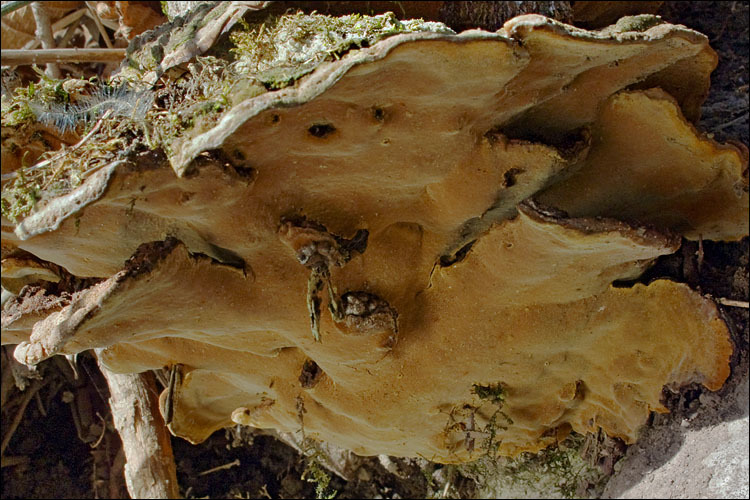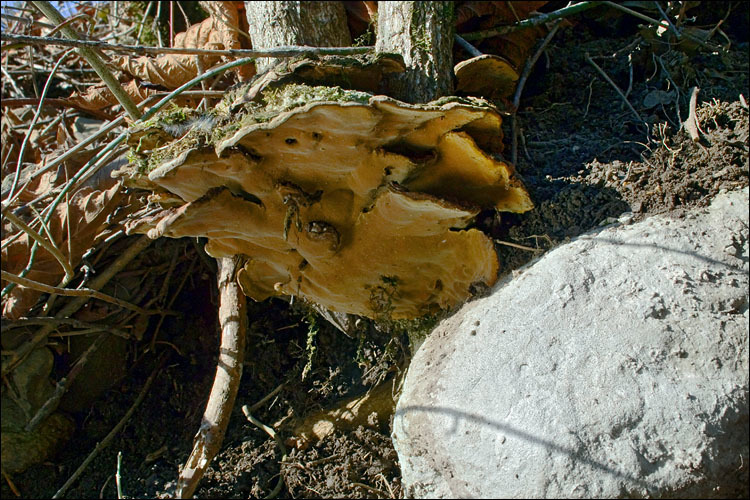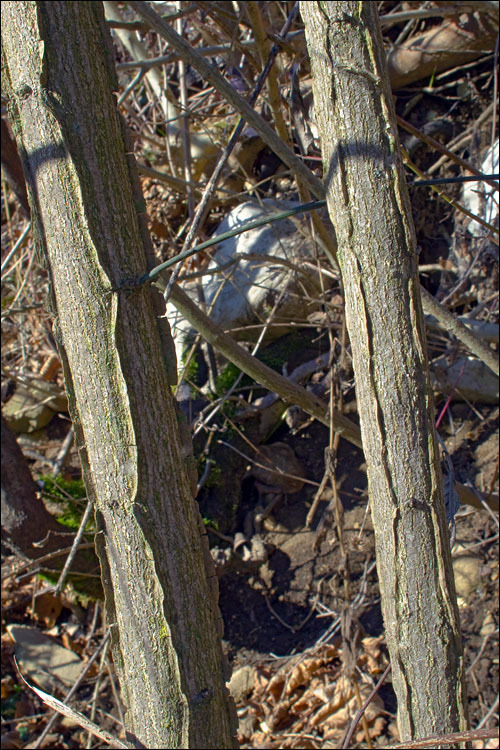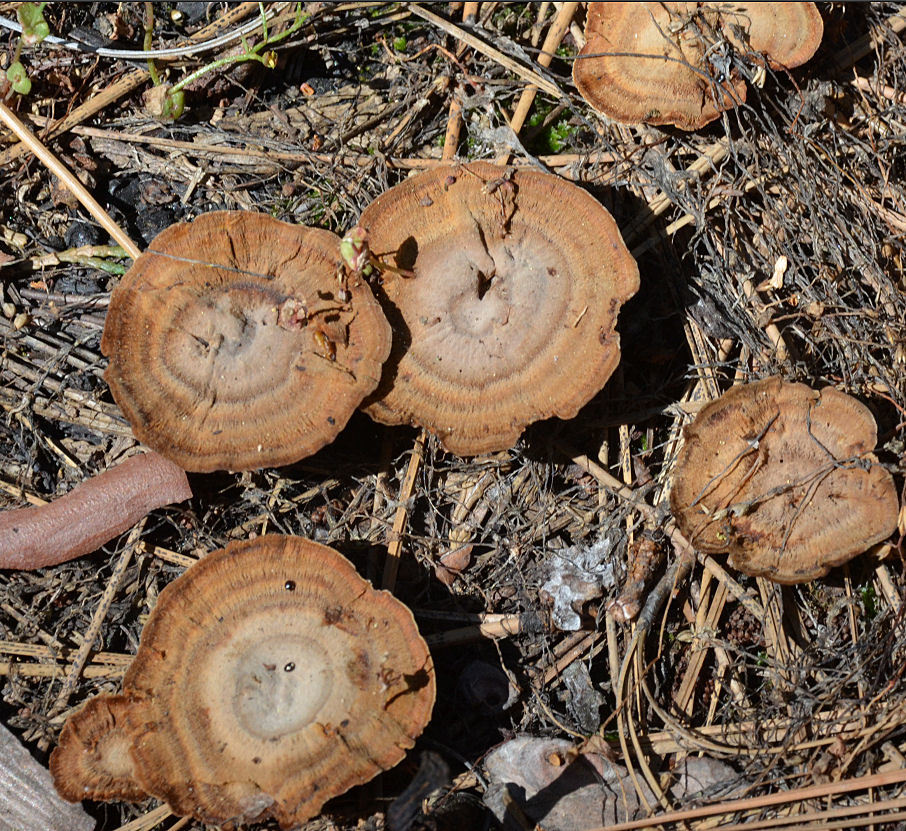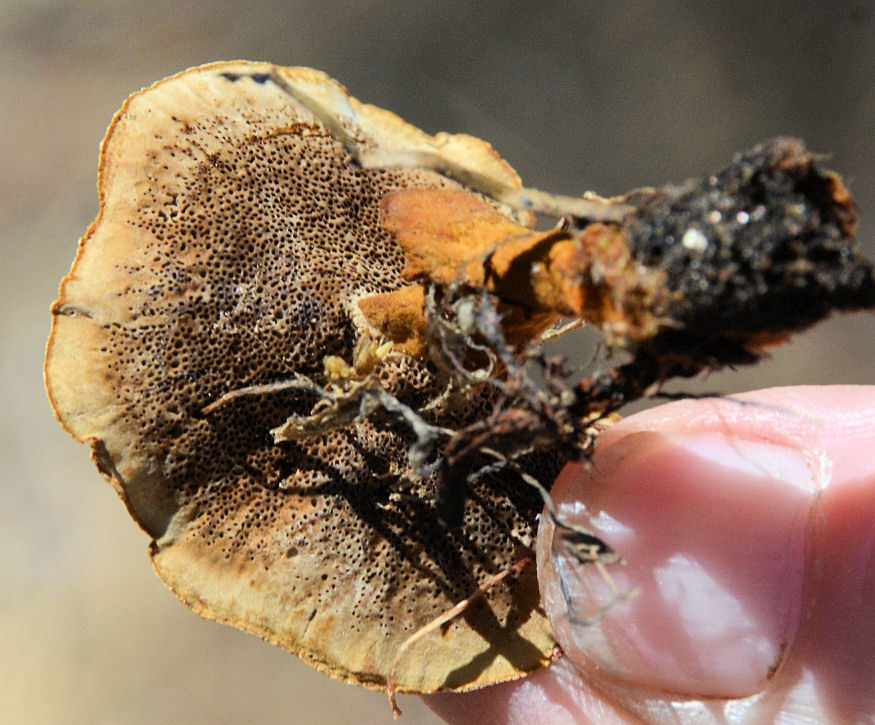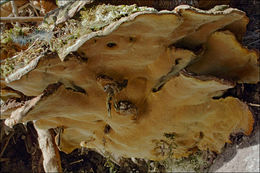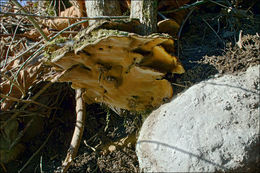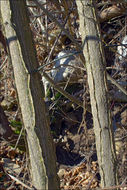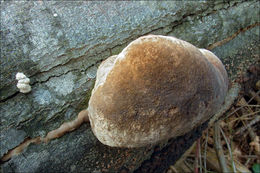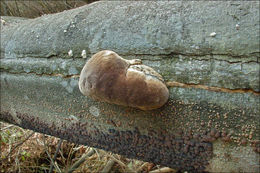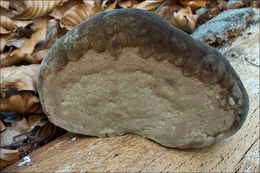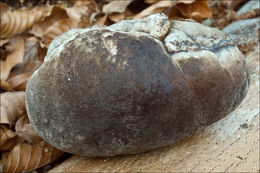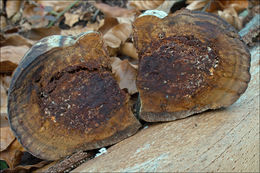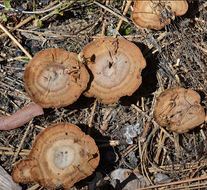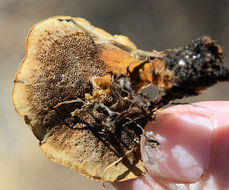-

Crossection. Slo.: ribezov plutač - syn.: Phellinus ribis, Phylloporia ribis f. euonymi - Habitat: Light broadleaf forest intermixed with unmaintained grassy meadows, flat terrain, old calcareous river deposits, partly shady, partly protected from direct rain by tree canopies, average precipitations ~ 3.000 mm/year, average temperature 8-10 deg C, elevation 365 m (1.200 feet), alpine phytogeographical region. - Substratum: Euonymus europaea - Comments: Growing solitary at the base of a middle size Euonymus europaea bush situated under a large Fagus sylvatica, alive but not in a good health condition. Pileus diameter up to 15 cm x 10 cm (6 inch x 4 inch) and 3 cm (1.2 inch) thick, hard, difficult to cut through, corky. Cap upper side dark tobacco color (oac638), almost totally covered by mosses. Context somewhat lighter than cap (oac644). Pore layer concolorous with context, pore surface ocher-brown (oac777). SP whitish-crme. - Spores smooth, small, abundant. Dimensions 3.4 (SD = 0.2) x 2.7 (SD = 0.2) micr., Q = 1.27 (SD = 0.09), n = 30. Motic B2-211A, magnification 1.000 x, oil, in water. - Ref.: (1) A.Bernicchia, Polyporaceae s.l., Fungi Europaei, Vol. 10., Edizioni Candusso (2005), p 440. 3-4/2.5-3 (2) G.J.Krieglsteiner (Hrsg.), Die Grosspilze Bade-Wrttembergs, Band 1, Ulmer (2000), p 462. (3) Ryvarden, L.; Gilbertson, R.L. 1994, Syn. Fung. 7. p535 (after MycoBank) 3-4.5 x 2.5-3 m (4) Personal communication with Mr. Anton Poler, identification confirmed.
-
Slo.: ribezov plutač - syn.: Phellinus ribis, Phylloporia ribis f. euonymi - Habitat: Road side and wood side, almost flat terrain, edge, cretaceous clastic rock (flysh) bedrock, partly sunny place, exposed to direct rain, average precipitations ~ 3.000 mm/year, average temperature 8-10 deg C, elevation 430x m (1.400 feet), alpine phytogeographical region. - Substratum: at the very base of a medium size, alive and in good condition Euonymus europaea. - Comments: Growing solitary, very similar to previous observation. - Ref.: (1) A.Bernicchia, Polyporaceae s.l., Fungi Europaei, Vol. 10., Edizioni Candusso (2005), p 440. (2) G.J.Krieglsteiner (Hrsg.), Die Grosspilze Bade-Wrttembergs, Band 1, Ulmer (2000), p 462. (3) Ryvarden, L.; Gilbertson, R.L. 1994, Syn. Fung. 7. p535 (after MycoBank) Canon G11, 6.1-30mm/f2.8-4.5
-
Slo.: ribezov plutač - syn.: Phellinus ribis, Phylloporia ribis f. euonymi - Habitat: Road side and wood side, almost flat terrain, edge, cretaceous clastic rock (flysh) bedrock, partly sunny place, exposed to direct rain, average precipitations ~ 3.000 mm/year, average temperature 8-10 deg C, elevation 430x m (1.400 feet), alpine phytogeographical region. - Substratum: at the very base of a medium size, alive and in good condition Euonymus europaea. - Comments: Growing solitary, very similar to previous observation. - Ref.: (1) A.Bernicchia, Polyporaceae s.l., Fungi Europaei, Vol. 10., Edizioni Candusso (2005), p 440. (2) G.J.Krieglsteiner (Hrsg.), Die Grosspilze Bade-Wrttembergs, Band 1, Ulmer (2000), p 462. (3) Ryvarden, L.; Gilbertson, R.L. 1994, Syn. Fung. 7. p535 (after MycoBank) Canon G11, 6.1-30mm/f2.8-4.5
-
Host with typical ribs in bark. - Slo.: ribezov plutač - syn.: Phellinus ribis, Phylloporia ribis f. euonymi - Habitat: Road side and wood side, almost flat terrain, edge, cretaceous clastic rock (flysh) bedrock, partly sunny place, exposed to direct rain, average precipitations ~ 3.000 mm/year, average temperature 8-10 deg C, elevation 430x m (1.400 feet), alpine phytogeographical region. - Substratum: at the very base of a medium size, alive and in good condition Euonymus europaea. - Comments: Growing solitary, very similar to previous observation. - Ref.: (1) A.Bernicchia, Polyporaceae s.l., Fungi Europaei, Vol. 10., Edizioni Candusso (2005), p 440. (2) G.J.Krieglsteiner (Hrsg.), Die Grosspilze Bade-Wrttembergs, Band 1, Ulmer (2000), p 462. (3) Ryvarden, L.; Gilbertson, R.L. 1994, Syn. Fung. 7. p535 (after MycoBank) Canon G11, 6.1-30mm/f2.8-4.5
-

Slo.: vrbov puta - syn.: Ochroporus cinereus (Niemel) Fischer, Phellinus alni (Bondartsev) Parmasto, Ochroporus ossatus Fischer, Fomes igniarius (Fr.ex.L.) Gillet - Habitat: Soa river shore, mixed forest (Pinus sp. and Picea abies dominant), south oriented slope, calcareous ground (conglomerate), humid air, sunny and relatively warm place, exposed to direct rain, average precipitations ~ 3.000 mm/year, average temperature 8-10 deg C, elevation 400 m (1.300 feet), alpine phytogeographical region.Substratum: fallen trunk of Fagus sylvatica in its initial stage of disintegration and massively infected also with Schizophyllum commune and Hypoxylon fragiforme.Comments: Phellinus igniarius (group) is without doubt the most difficult 'species' for determination of all members of genus Phellinus (Ref.3 and 4). It is extremely variable morphologically, but also microscopically traits are variable and barely sufficient to separate several taxa of this group (P. cinereus, P. igniarius s.str., P. alni). Several authors do not recognize fully these taxa. Antioxidative and anti-cancer effects of Phellinus igniarius extracts have been observed..There is no microscopy for this find; hence the determination is uncertain. However, young sporocarps of Phellinus igniarius often have roundish shape with rounded inflated pileus margin like this find. Dark (reddish) brown, woody and concentrically layered trama, pores and pileus surface and color correspond reasonably well to Phellinus igniarius, or, at least, this is the best fit I was able to find.Regarding substratum Salix is the most common for this species, but it has been found also on many other broadleaved trees. However, Fagus sylvatica is not mentioned in the literature available to me. This sheds some additional doubts in this determination.Growing solitary. 5% KOH on trama, pileus surface and pore surface dark-brown to almost back reaction. Pileus was woody/cocky, but not very hard to cut. (still young?).Ref.:(1) L. Ryvarden, I. Melo, Poroid fungi of Europe, Synopsis Fungorum 31., Fungiflora (2014), p 321. (2) J. Breitenbach, F. Kraenzlin, Eds., Fungi of Switzerland, Vol.2. Verlag Mykologia (1986), p 260. (3) G.J. Krieglsteiner (Hrsg.), Die Grosspilze Baden-Wrttembergs, Band 1., Ulmer (2000), p 455.(4) A. Bernicchia, Polyporaceae, s.l., Fungi Europaei, Vol. 10., Edizioni Candusso (2005), p 412.
-
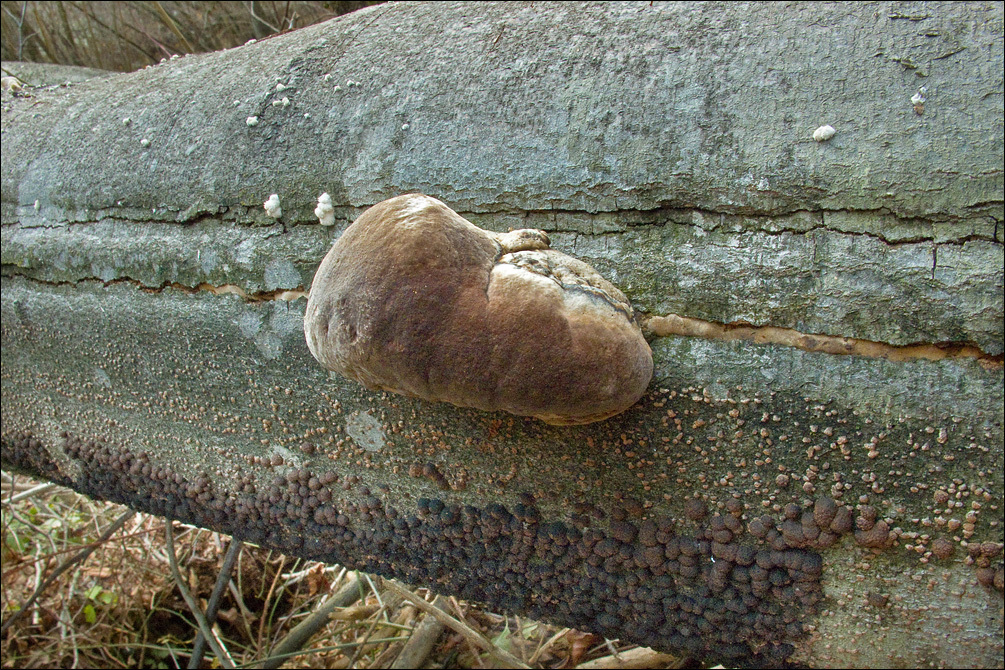
Slo.: vrbov puta - syn.: Ochroporus cinereus (Niemel) Fischer, Phellinus alni (Bondartsev) Parmasto, Ochroporus ossatus Fischer, Fomes igniarius (Fr.ex.L.) Gillet - Habitat: Soa river shore, mixed forest (Pinus sp. and Picea abies dominant), south oriented slope, calcareous ground (conglomerate), humid air, sunny and relatively warm place, exposed to direct rain, average precipitations ~ 3.000 mm/year, average temperature 8-10 deg C, elevation 400 m (1.300 feet), alpine phytogeographical region. Substratum: fallen trunk of Fagus sylvatica in its initial stage of disintegration and massively infected also with Schizophyllum commune and Hypoxylon fragiforme. Comments: Phellinus igniarius (group) is without doubt the most difficult 'species' for determination of all members of genus Phellinus (Ref.3 and 4). It is extremely variable morphologically, but also microscopically traits are variable and barely sufficient to separate several taxa of this group (P. cinereus, P. igniarius s.str., P. alni). Several authors do not recognize fully these taxa. Antioxidative and anti-cancer effects of Phellinus igniarius extracts have been observed.. There is no microscopy for this find; hence the determination is uncertain. However, young sporocarps of Phellinus igniarius often have roundish shape with rounded inflated pileus margin like this find. Dark (reddish) brown, woody and concentrically layered trama, pores and pileus surface and color correspond reasonably well to Phellinus igniarius, or, at least, this is the best fit I was able to find. Regarding substratum Salix is the most common for this species, but it has been found also on many other broadleaved trees. However, Fagus sylvatica is not mentioned in the literature available to me. This sheds some additional doubts in this determination. Growing solitary. 5% KOH on trama, pileus surface and pore surface dark-brown to almost back reaction. Pileus was woody/cocky, but not very hard to cut. (still young?). Ref.: (1) L. Ryvarden, I. Melo, Poroid fungi of Europe, Synopsis Fungorum 31., Fungiflora (2014), p 321. (2) J. Breitenbach, F. Kraenzlin, Eds., Fungi of Switzerland, Vol.2. Verlag Mykologia (1986), p 260. (3) G.J. Krieglsteiner (Hrsg.), Die Grosspilze Baden-Wrttembergs, Band 1., Ulmer (2000), p 455. (4) A. Bernicchia, Polyporaceae, s.l., Fungi Europaei, Vol. 10., Edizioni Candusso (2005), p 412.
-
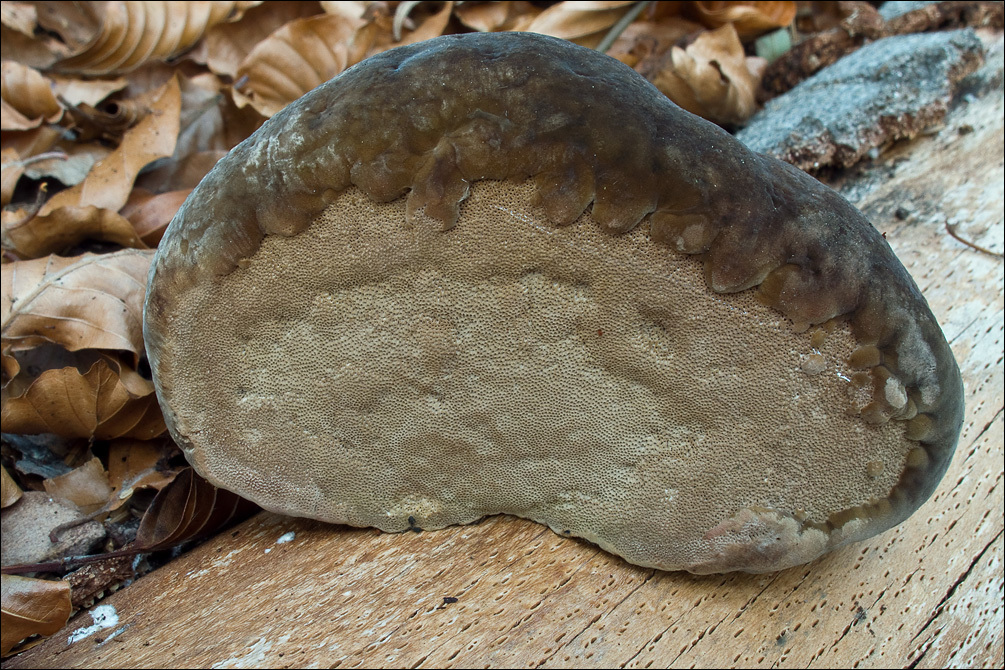
Slo.: vrbov puta - syn.: Ochroporus cinereus (Niemel) Fischer, Phellinus alni (Bondartsev) Parmasto, Ochroporus ossatus Fischer, Fomes igniarius (Fr.ex.L.) Gillet - Habitat: Soa river shore, mixed forest (Pinus sp. and Picea abies dominant), south oriented slope, calcareous ground (conglomerate), humid air, sunny and relatively warm place, exposed to direct rain, average precipitations ~ 3.000 mm/year, average temperature 8-10 deg C, elevation 400 m (1.300 feet), alpine phytogeographical region. Substratum: fallen trunk of Fagus sylvatica in its initial stage of disintegration and massively infected also with Schizophyllum commune and Hypoxylon fragiforme. Comments: Phellinus igniarius (group) is without doubt the most difficult 'species' for determination of all members of genus Phellinus (Ref.3 and 4). It is extremely variable morphologically, but also microscopically traits are variable and barely sufficient to separate several taxa of this group (P. cinereus, P. igniarius s.str., P. alni). Several authors do not recognize fully these taxa. Antioxidative and anti-cancer effects of Phellinus igniarius extracts have been observed.. There is no microscopy for this find; hence the determination is uncertain. However, young sporocarps of Phellinus igniarius often have roundish shape with rounded inflated pileus margin like this find. Dark (reddish) brown, woody and concentrically layered trama, pores and pileus surface and color correspond reasonably well to Phellinus igniarius, or, at least, this is the best fit I was able to find. Regarding substratum Salix is the most common for this species, but it has been found also on many other broadleaved trees. However, Fagus sylvatica is not mentioned in the literature available to me. This sheds some additional doubts in this determination. Growing solitary. 5% KOH on trama, pileus surface and pore surface dark-brown to almost back reaction. Pileus was woody/cocky, but not very hard to cut. (still young?). Ref.: (1) L. Ryvarden, I. Melo, Poroid fungi of Europe, Synopsis Fungorum 31., Fungiflora (2014), p 321. (2) J. Breitenbach, F. Kraenzlin, Eds., Fungi of Switzerland, Vol.2. Verlag Mykologia (1986), p 260. (3) G.J. Krieglsteiner (Hrsg.), Die Grosspilze Baden-Wrttembergs, Band 1., Ulmer (2000), p 455. (4) A. Bernicchia, Polyporaceae, s.l., Fungi Europaei, Vol. 10., Edizioni Candusso (2005), p 412.
-
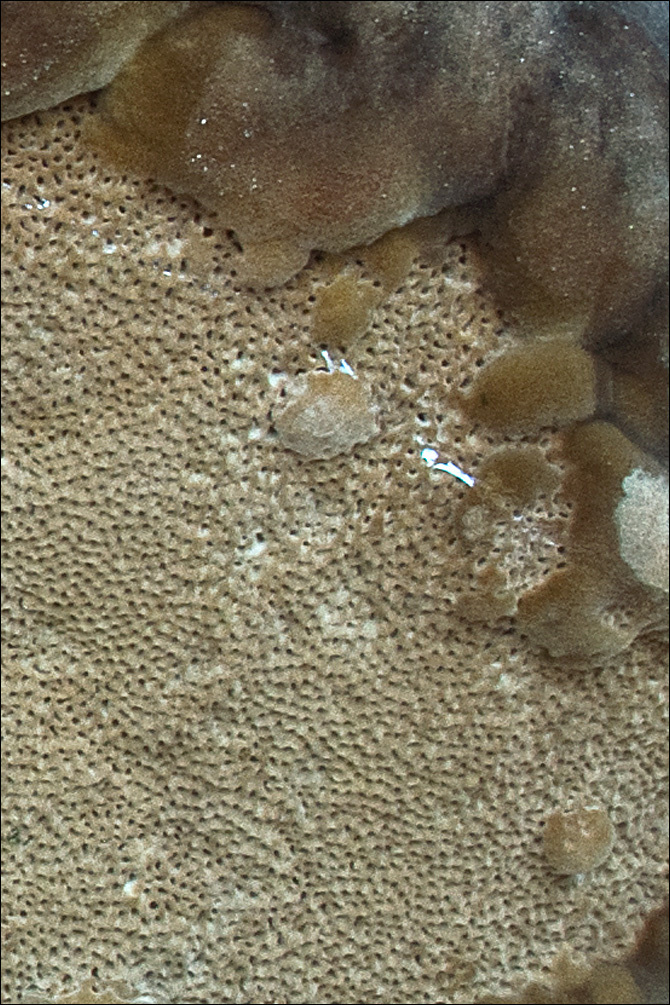
Slo.: vrbov puta - syn.: Ochroporus cinereus (Niemel) Fischer, Phellinus alni (Bondartsev) Parmasto, Ochroporus ossatus Fischer, Fomes igniarius (Fr.ex.L.) Gillet - Habitat: Soa river shore, mixed forest (Pinus sp. and Picea abies dominant), south oriented slope, calcareous ground (conglomerate), humid air, sunny and relatively warm place, exposed to direct rain, average precipitations ~ 3.000 mm/year, average temperature 8-10 deg C, elevation 400 m (1.300 feet), alpine phytogeographical region. Substratum: fallen trunk of Fagus sylvatica in its initial stage of disintegration and massively infected also with Schizophyllum commune and Hypoxylon fragiforme. Comments: Phellinus igniarius (group) is without doubt the most difficult 'species' for determination of all members of genus Phellinus (Ref.3 and 4). It is extremely variable morphologically, but also microscopically traits are variable and barely sufficient to separate several taxa of this group (P. cinereus, P. igniarius s.str., P. alni). Several authors do not recognize fully these taxa. Antioxidative and anti-cancer effects of Phellinus igniarius extracts have been observed.. There is no microscopy for this find; hence the determination is uncertain. However, young sporocarps of Phellinus igniarius often have roundish shape with rounded inflated pileus margin like this find. Dark (reddish) brown, woody and concentrically layered trama, pores and pileus surface and color correspond reasonably well to Phellinus igniarius, or, at least, this is the best fit I was able to find. Regarding substratum Salix is the most common for this species, but it has been found also on many other broadleaved trees. However, Fagus sylvatica is not mentioned in the literature available to me. This sheds some additional doubts in this determination. Growing solitary. 5% KOH on trama, pileus surface and pore surface dark-brown to almost back reaction. Pileus was woody/cocky, but not very hard to cut. (still young?). Ref.: (1) L. Ryvarden, I. Melo, Poroid fungi of Europe, Synopsis Fungorum 31., Fungiflora (2014), p 321. (2) J. Breitenbach, F. Kraenzlin, Eds., Fungi of Switzerland, Vol.2. Verlag Mykologia (1986), p 260. (3) G.J. Krieglsteiner (Hrsg.), Die Grosspilze Baden-Wrttembergs, Band 1., Ulmer (2000), p 455. (4) A. Bernicchia, Polyporaceae, s.l., Fungi Europaei, Vol. 10., Edizioni Candusso (2005), p 412.
-

Slo.: vrbov puta - syn.: Ochroporus cinereus (Niemel) Fischer, Phellinus alni (Bondartsev) Parmasto, Ochroporus ossatus Fischer, Fomes igniarius (Fr.ex.L.) Gillet - Habitat: Soa river shore, mixed forest (Pinus sp. and Picea abies dominant), south oriented slope, calcareous ground (conglomerate), humid air, sunny and relatively warm place, exposed to direct rain, average precipitations ~ 3.000 mm/year, average temperature 8-10 deg C, elevation 400 m (1.300 feet), alpine phytogeographical region. Substratum: fallen trunk of Fagus sylvatica in its initial stage of disintegration and massively infected also with Schizophyllum commune and Hypoxylon fragiforme. Comments: Phellinus igniarius (group) is without doubt the most difficult 'species' for determination of all members of genus Phellinus (Ref.3 and 4). It is extremely variable morphologically, but also microscopically traits are variable and barely sufficient to separate several taxa of this group (P. cinereus, P. igniarius s.str., P. alni). Several authors do not recognize fully these taxa. Antioxidative and anti-cancer effects of Phellinus igniarius extracts have been observed.. There is no microscopy for this find; hence the determination is uncertain. However, young sporocarps of Phellinus igniarius often have roundish shape with rounded inflated pileus margin like this find. Dark (reddish) brown, woody and concentrically layered trama, pores and pileus surface and color correspond reasonably well to Phellinus igniarius, or, at least, this is the best fit I was able to find. Regarding substratum Salix is the most common for this species, but it has been found also on many other broadleaved trees. However, Fagus sylvatica is not mentioned in the literature available to me. This sheds some additional doubts in this determination. Growing solitary. 5% KOH on trama, pileus surface and pore surface dark-brown to almost back reaction. Pileus was woody/cocky, but not very hard to cut. (still young?). Ref.: (1) L. Ryvarden, I. Melo, Poroid fungi of Europe, Synopsis Fungorum 31., Fungiflora (2014), p 321. (2) J. Breitenbach, F. Kraenzlin, Eds., Fungi of Switzerland, Vol.2. Verlag Mykologia (1986), p 260. (3) G.J. Krieglsteiner (Hrsg.), Die Grosspilze Baden-Wrttembergs, Band 1., Ulmer (2000), p 455. (4) A. Bernicchia, Polyporaceae, s.l., Fungi Europaei, Vol. 10., Edizioni Candusso (2005), p 412.
-
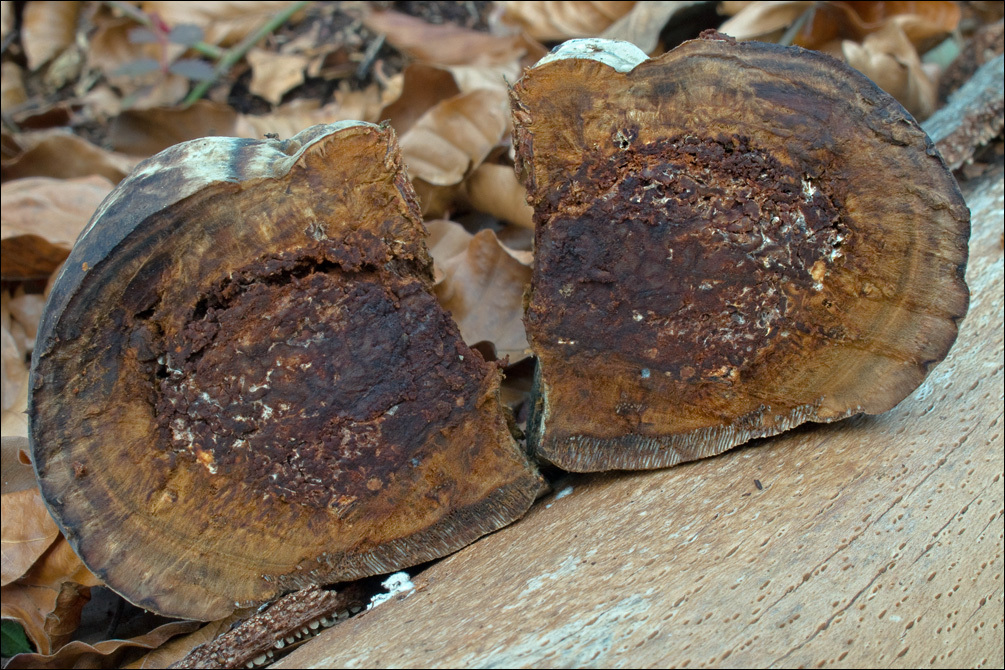
Slo.: vrbov puta - syn.: Ochroporus cinereus (Niemel) Fischer, Phellinus alni (Bondartsev) Parmasto, Ochroporus ossatus Fischer, Fomes igniarius (Fr.ex.L.) Gillet - Habitat: Soa river shore, mixed forest (Pinus sp. and Picea abies dominant), south oriented slope, calcareous ground (conglomerate), humid air, sunny and relatively warm place, exposed to direct rain, average precipitations ~ 3.000 mm/year, average temperature 8-10 deg C, elevation 400 m (1.300 feet), alpine phytogeographical region. Substratum: fallen trunk of Fagus sylvatica in its initial stage of disintegration and massively infected also with Schizophyllum commune and Hypoxylon fragiforme. Comments: Phellinus igniarius (group) is without doubt the most difficult 'species' for determination of all members of genus Phellinus (Ref.3 and 4). It is extremely variable morphologically, but also microscopically traits are variable and barely sufficient to separate several taxa of this group (P. cinereus, P. igniarius s.str., P. alni). Several authors do not recognize fully these taxa. Antioxidative and anti-cancer effects of Phellinus igniarius extracts have been observed.. There is no microscopy for this find; hence the determination is uncertain. However, young sporocarps of Phellinus igniarius often have roundish shape with rounded inflated pileus margin like this find. Dark (reddish) brown, woody and concentrically layered trama, pores and pileus surface and color correspond reasonably well to Phellinus igniarius, or, at least, this is the best fit I was able to find. Regarding substratum Salix is the most common for this species, but it has been found also on many other broadleaved trees. However, Fagus sylvatica is not mentioned in the literature available to me. This sheds some additional doubts in this determination. Growing solitary. 5% KOH on trama, pileus surface and pore surface dark-brown to almost back reaction. Pileus was woody/cocky, but not very hard to cut. (still young?). Ref.: (1) L. Ryvarden, I. Melo, Poroid fungi of Europe, Synopsis Fungorum 31., Fungiflora (2014), p 321. (2) J. Breitenbach, F. Kraenzlin, Eds., Fungi of Switzerland, Vol.2. Verlag Mykologia (1986), p 260. (3) G.J. Krieglsteiner (Hrsg.), Die Grosspilze Baden-Wrttembergs, Band 1., Ulmer (2000), p 455. (4) A. Bernicchia, Polyporaceae, s.l., Fungi Europaei, Vol. 10., Edizioni Candusso (2005), p 412.
-
-



